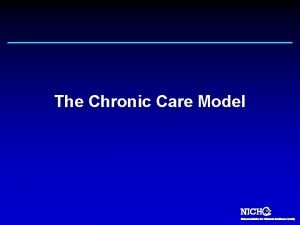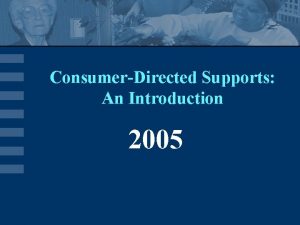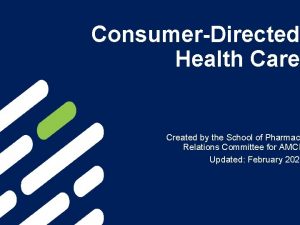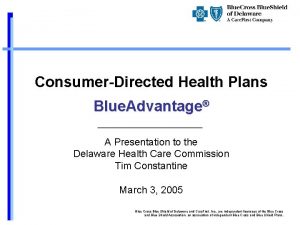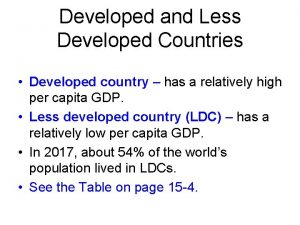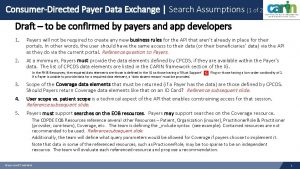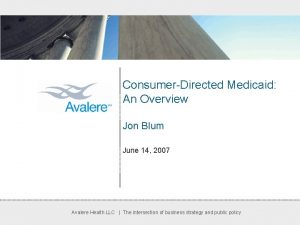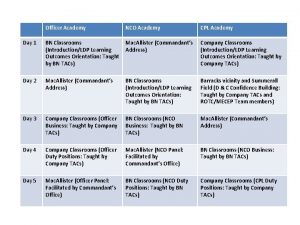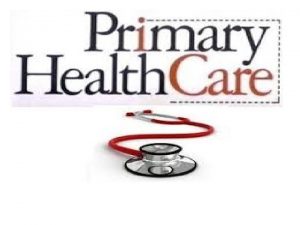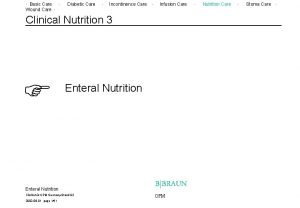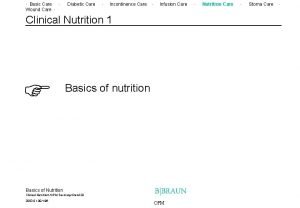ConsumerDirected Health Care Presentation Developed for the Academy























- Slides: 23

Consumer-Directed Health Care Presentation Developed for the Academy of Managed Care Pharmacy Updated: February 2014

What is Consumer-Directed Health Care (CDHC) Patients: • Control their own health care spending • Decide what health plan to join • Decide what treatment to receive • Decide on the provider for their treatment

CDHC Features • CDHC consists of health insurance plans that usually have: – a tax-advantaged health savings account (HSA) or health reimbursement account (HRA); – a high-deductible health plan (HDHP) and lower premium compared to non-CDHC; and, – tools to help make healthcare decisions

How Do CDHC Plans Differ from Traditional Health Plans • In traditional health plans, patients pay a premium for health insurance coverage • It has traditionally been the physician’s job to consider the risks vs. benefits of health care services that the patient needs without a patient’s consideration of costs

Background of CDHC • With health care costs rising faster than inflation, CDHC is being promoted as a way to combat these costs and still provide quality healthcare • Shifting costs to patients may empower them to take charge of their own health care • Patients will likely only use services that they need, as they will be paying more out of pocket (e. g. patients will use a retail clinic for a sore throat vs. a trip to the ER) Blumenthal D. Employer-sponsored insurance – riding the health care tiger. NEJM. 2006; 355(2): 195 -202.

How it works • In CDHC with savings option plans, patients pay for health care services with a tax-advantaged or HRA • After the account runs out, the patient pays out of pocket until reaching the deductible and/or out of pocket max • Deductibles in these plans are often thousands of dollars • Once the deductible is met, patients typically share the cost of medical services with the health plan (by paying co-insurance) • A catastrophic component of the health plan covers major emergencies

Goals of CDHC Plans with savings options • Reduce costs by discouraging the use of inappropriate services • Encourage patients to comparison shop and request quality data for services and providers • Designed to get patients to play a bigger role in keeping costs low • If patients pay more out of pocket for health care, they may be more prudent in seeking health care treatments • Providers must then offer higher quality services in order to compete for business • In theory, this will eventually decrease health care costs Blumenthal D. Employer-sponsored insurance – riding the health care tiger. NEJM. 2006; 355(2): 195 -202.

Health Savings Accounts and Relationship to CDHC plans • Created by the Medicare Modernization Act of 2003 • Accounts allow patients enrolled in a HDHP to contribute and withdraw funds tax-free to cover health care costs • Can be contributed to by employees or employers • Once deposited, the funds belong to the employee, and can travel with them to wherever they work • When the account balance runs out, the patient then pays out of pocket (similar to a regular deductible) • Unused funds can be “rolled over” to the next year Carey M A. HSA Provisions Draw Praise, Scrutiny. The Commonwealth Fund. http: //www. commonwealthfund. org/Content/Newsletters/Washington-Health-Policy-in-Review/2006/Dec/Washington. Health-Policy-Week-in-Review---December-18 --2006/HSA-Provisions-Draw-Praise--Scrutiny. aspx. Accessed January 23, 2011.

HSA stats • Fifteen percent of US firms offered HSAs in 2010 • Nineteen percent of covered workers were enrolled in HSAs in 2012 • Enrollment in CDHD with savings options still makes up a very small segment of the overall insurance market • Larger firms are more likely to offer HSAs than smaller firms Employer health benefits: 2012 summary of findings. Washington D. C. : Kaiser Family Foundation, 2010. http: //ehbs. kff. org. Accessed February 28, 2012.

Health Reimbursement Accounts (HRA) • Similar to HSAs • Employers reimburse all or part of the employee’s out-of-pocket expenses (but do not deposit funds into an account) • Companies offer credit to employees • Employer discretion to allow credit to be “rolled over” to the next year Blumenthal D. Employer-sponsored insurance – riding the health care tiger. NEJM. 2006; 355(2): 195 -202.

Other Features of CDHC Plans • Some CDHC plans cover preventive care, routine checkups, lab tests, vaccines, and health screenings • Some have on-line tools containing medical information for patients (e. g. , information on vaccines, hypertension, etc. ) • Some offer information on both price and quality of the services and physicians • High-deductible component protects patients against catastrophic medical expenses Beeuwkes Buntin M. et al, Consumer-directed health care: early evidence about effects on cost and quality. Health Affairs. 2007; 25(6): 516 -530.

The Health Insurance Experiment • The classic, decades old RAND Health Insurance Experiment confirmed: – patients used fewer services when they paid more for them out of pocket – patients reduced the use of necessary and unnecessary services at the same rate RAND Health. The Health Insurance Experiment: a classic RAND study speaks to the current reform debate. Research Highlights, July 24, 2007. www. rand. org/pubs/research_briefs/RB 9174/index 1. html. Accessed January 23, 2011.

RAND Health Research 2007 Key Findings • Patients with CDHC plans generally spent less on health care and used fewer health care services • CDHC plans had mixed effects on quality of care (Patients used more preventive services but some may have forgone care) • Patients had a lower level of satisfaction • Patients lacked adequate information to make informed medical care choices Beeuwkes Buntin M. et al, Consumer-directed health care: early evidence about effects on cost and quality. Health Affairs. 2007; 25(6): 516 -530.

2007 EBRI/Commonwealth Fund Consumerism in Health Survey • For patients enrolled in CDHC plans: – Enrollment remains low – Patients have higher incomes than in traditional plans – Health status is better – More cost-conscious behavior – More likely to skip on needed medical care due to costs – Lower satisfaction with CDHC plan – Limited information on provider cost and care Finding from the 2007 EBRI/Commonwealth Fund Consumerism in Health Survey. New York: Commonwealth Fund 2007. http: //www. ebri. org. Accessed February 19, 2010.

Pros of CDHC Plans • May lower health care costs • Lowers costs for employers • Patients play a bigger role in managing their health care • May reduce the use of inappropriate health care services Finding from the 2007 EBRI/Commonwealth Fund Consumerism in Health Survey. New York: Commonwealth Fund 2007. http: //www. ebri. org. Accessed January 23, 2011. Beeuwkes Buntin M. et al, Consumer-directed health care: early evidence about effects on cost and quality. Health Affairs. 2007; 25(6): 516 -530.

Cons of CDHC Plans • Lack of information on pricing and quality of services and providers • Overall, low health literacy in US • Sicker patients may need to pay more out of pocket and may not be able to afford it • Potential for patients to skip services/care they need

Cons of CDHC Plans Continued • May disproportionately attract healthy patients (since premiums are lower in these plans than in traditional plans) • If healthier patients leave traditional plans, then sicker patients left in these plans may drive up costs • This concept is known as adverse selection Finding from the 2007 EBRI/Commonwealth Fund Consumerism in Health Survey. New York: Commonwealth Fund 2007. http: //www. ebri. org. Accessed January 23, 2011. Beeuwkes Buntin M. et al, Consumer-directed health care: early evidence about effects on cost and quality. Health Affairs. 2007; 25(6): 516 -530.

Considerations • The challenge of a CDHC plan design is to promote cost-consciousness and discourage the use of inappropriate services without deterring patients from seeking needed care • New studies are underway to determine impact and effectiveness of CDHC plans Beeuwkes Buntin M. et al, Consumer-directed health care: early evidence about effects on cost and quality. Health Affairs. 2007; 25(6): 516 -530.

CDHC Plans and the Marketplace • There are HSA eligible plans available in the marketplace • There is some thought that HDHPs may be an attractive option for some marketplace consumers

Summary • Enrollment in CDHC plans remains low • There is lower patient satisfaction in these plans than in traditional health plans • Patients enrolled in CDHC plans are using more costconscious behavior • More information is needed on quality and cost of care of providers and services in order to make CDHC work more effectively • It remains to be seen if CDHC will have a large impact on lowering costs in the US health care system • More data is needed to determine the effects on cost and quality of care

References • Beeuwkes Buntin M. et al, Consumer-directed health care: early evidence about effects on cost and quality. Health Affairs. 2007; 25(6): 516 -530. • Blumenthal D. Employer-sponsored insurance – riding the health care tiger. NEJM. 2006; 355(2): 195 -202. • Carey M A. HAS Provisions Draw Praise, Scrutiny. The Commonwealth Fund. http: //www. commonwealthfund. org/Content/Newsletters/Washington. Health-Policy-in-Review/2006/Dec/Washington-Health-Policy-Week-in. Review---December-18 --2006/HSA-Provisions-Draw-Praise--Scrutiny. aspx. Accessed January 23, 2011. • Consumer-Directed Health Arrangements: Background Brief. The Henry J Kaiser Family Foundation. http: //www. kaiseredu. org/Issue. Modules/Consumer-Directed-Health-Arrangements/Background. Brief. aspx. Accessed January 23, 2011.

References • Employer health benefits: 2012 summary of findings. Washington D. C. : Kaiser Family Foundation, 2012. http: //ehbs. kff. org. Accessed February 28, 2012. • Finding from the 2007 EBRI/Commonwealth Fund Consumerism in Health Survey. New York: Commonwealth Fund 2007. http: //www. ebri. org. Accessed February 19, 2010. • RAND Health. The Health Insurance Experiment: a classic RAND study speaks to the current reform debate. Research Highlights, July 24, 2007. www. rand. org/pubs/research_briefs/RB 9174/index 1. html. Accessed January 23, 2011.

Thank you to AMCP member Don Klepser for updating this presentation for 2014.
 Primary secondary tertiary health care
Primary secondary tertiary health care Health and social care unit 2
Health and social care unit 2 Chronic care model wagner
Chronic care model wagner Health and social care component 3 health and wellbeing
Health and social care component 3 health and wellbeing Iso 22301 utbildning
Iso 22301 utbildning Novell typiska drag
Novell typiska drag Nationell inriktning för artificiell intelligens
Nationell inriktning för artificiell intelligens Vad står k.r.å.k.a.n för
Vad står k.r.å.k.a.n för Varför kallas perioden 1918-1939 för mellankrigstiden
Varför kallas perioden 1918-1939 för mellankrigstiden En lathund för arbete med kontinuitetshantering
En lathund för arbete med kontinuitetshantering Underlag för särskild löneskatt på pensionskostnader
Underlag för särskild löneskatt på pensionskostnader Personlig tidbok fylla i
Personlig tidbok fylla i Sura för anatom
Sura för anatom Densitet vatten
Densitet vatten Datorkunskap för nybörjare
Datorkunskap för nybörjare Tack för att ni lyssnade bild
Tack för att ni lyssnade bild Debattinlägg mall
Debattinlägg mall Delegerande ledarstil
Delegerande ledarstil Nyckelkompetenser för livslångt lärande
Nyckelkompetenser för livslångt lärande Påbyggnader för flakfordon
Påbyggnader för flakfordon Arkimedes princip formel
Arkimedes princip formel Publik sektor
Publik sektor Lyckans minut erik lindorm analys
Lyckans minut erik lindorm analys Presentera för publik crossboss
Presentera för publik crossboss


